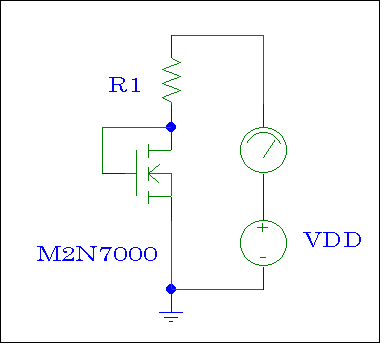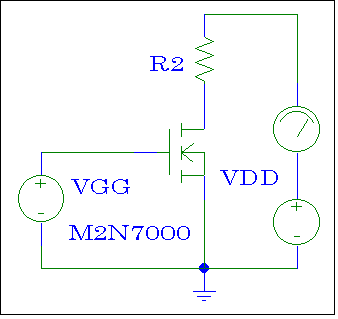The George Washington University
School of Engineering and Applied Science
Department of Electrical and Computer
Engineering
ECE 20 - Spring 2003
Experiment
# 7
N-Channel Enhancement MOSFETs
Testing & Characteristics
Equipment:
You must make up a complete equipment list and have your instructor review it
before you start.
Components:
Q1 - 2N7000 MOSFET
R1 - 12 kW
R2 - 300 W
Objectives:
- To obtain device characteristics from technical data
- To obtain several device characteristics by direct test and measurement
- To obtain several characteristic curves by plotting the information taken from a test circuit
- To obtain the IV Characteristic Curves for a MOSFET by using a Tektronix Model 571 Curve Tracer
- To obtain several characteristic curves by changing model parameters of the transistor in ORCAD
- To verify manufacturer specifications
1.- (HW) Transistor specifications, ratings and symbols
a) Refer to the specifications for the 2N7000 and find the following information:
transistor type,
the maximum total power it can dissipate at 250C (PD),
its maximum continuous drain current rating (ID),
the maximum gate-source voltage rating (VGS),
its operating temperature range (TJ),
its maximum drain-source voltage rating (VDSS),
its maximum zero gate voltage drain current IDSS when VDS = 48 V & VGS = 0,
its maximum drain-gate voltage when RGS = 1 mW,
its maximum static drain-source on-resistance (rDS) when VGS = 10VDC & ID =
0.5 ADC,
its maximum and minimum gate threshold voltage (VGS(th)) when VDS = VGS &
ID = 1mA,
its minimum forward transconductance (gfs) when VDS = 10 V & ID = 200 mA,
its drain-source on-voltage (VDS(on)) when VGS = 10 V & ID = 0.5 ADC,
and its minimum on-state drain current (ID(on)) when VGS = 4.5 V & VDS = 10
V.
--> Place all this information in Data Table A - 2N7000 Specifications & Ratings.
b) Identify the gate, drain and source pins of the 2N7000. Draw a pin out diagram of this device and call it Figure A - Pin Out Diagram of 2N7000.
c) Draw the internal circuit of the 2N7000 chip. Label this as Figure B - Internal circuit of the 2N7000 chip
d) Draw and label the electrical symbols for a depletion N-Channel MOSFET
and depletion P-Channel MOSFET. Draw and label the electrical symbols for an
enhancement N-Channel MOSFET and enhancement P-Channel MOSFET. Place this
information in Figure C -Types of MOSFETs & Their Electrical Symbols.
2.- Static Measurements
a) Set the ohm meter to its highest scale. Measure and record the
resistance(R)
i)between the gate and source
ii)between the gate and drain
iii)between the drain and source.
Place this information in Data Table B - 2N7000 Static Characteristics.
b) Based on the resistance values gotten from the measurement, do you think the MOSFET works properly? Explain.
c)Test the built-in diode protection of Q1 with the diode test feature found
on the Keithley Model 175.
Measure and record the forward and reverse biased readings of Q1. Include this
information in Data Table B.
3.- Find VGS(th) when VDS = VGS & ID = 1 mA

Test Circuit #1
Assemble the circuit depicted above and then adjust VDD until the drain
current (displayed on the ammeter) is equal to 1.00 mA DC. Record the the value
of VGS(th).
4.- Find VDS(on) when VGS = 4.5 V & ID = 75 mA

Test Circuit #2
Completely assemble this circuit above; adjust VGG to 3.5 VDC and then
adjust VDD until the drain current (displayed on the ammeter) is equal to 75.0
mADC. Record the value of VDS(on).
5- (HW) Transfer Characteristics ( ID vs. VGS) for different transistor parameters using ORCAD
With the help of ORCAD plot ID vs. VGS for VDS = 10 Volts DC. Vary the value
of VGS in the 0 to 4 Volts range.
Repeat this experiment for the following conditions:
a) b ( named ‘KP’ in ORCAD) is ten times its default value. Do not change the value of any of the other parameters. Make sure to LABEL simulation CLEARLY.
b) W (width of the transistor) is twenty times its default value. Do not change the value of any of the other parameters. Make sure to LABEL simulation CLEARLY.
c) tox ( gate oxide thickness ) is twenty times its default value. Do
not change the value of any of the other parameters.
Make sure to LABEL simulation CLEARLY.
d) Based on the simulation results, explain what happens to the graph
of ID vs VGS when:
i) b value increase.
ii) W value increase.
iii) tox value increase.
6.- Find the Transfer Characteristic Curve (ID vs. VGS)
Using Test Circuit # 2: Place one voltmeter between the drain and source of
Q1 to measure VDS and place a second voltmeter between the gate and source to
measure the VGS of Q1. Completely assemble this circuit. Keep VDS set to
10 VDC while you step VGG in 0.1 VDC increments starting at [ VGS(th) + 0.05
VDC ] and stopping [ VGS(th) + 1.05 VDC ]. Measure and record ID for each
increment of VGS. Place this information in Data Table C - 2N7000 Transfer
Characteristic Curve Data (ID vs. VGS). Make a plot using the data
collected and label the plot "Plot 6a - ID vs VGS"
7.- ID vs. VDS Characteristics Using a Curve Tracer
Obtain a copy of a family of 10 curves for the 2N7000 from the Tektronix
Model 571 Curve tracer. Set ID to be no greater than 50 mA, VDS to be no
greater than 10 V, VG to step 10 times in 0.1 V steps, the offset voltage to
0.05 V more than VGS(th) and Pmax to .5 Watt.
Label the plot "Plot 7 - ID vs VGS (Curve Tracer)"
8 - Analysis
- Compare the value of VGS(th) you measured to the value specified in Data Table A.
- Plot the data contained in Data Table C and calculate K for the 2N7000 (its units will be in amps/volts2.)
- Compare the data in Data Table C to the curves you obtained from the curve tracer when VDS = 10.
- IC vs VCE(BJT) is the equivalence of ID vs VDS(MOSFET). What is the MOSFET equivalent of
IB vs. VBE( BJT) ? Explain.
- Use the ID vs VDS characteristic curves to find gm @ VDS=5 Volts and VGS= Vth + 1 Volt
- Use ID vs VDS characteristic curves to find the early voltage (VA)
- Draw the small signal equivalent circuit model for this MOSFET and indicate the values of the small signal parameters gm and ro for the operating point VDS=5 Volts and VGS= Vth + 1 Volt.